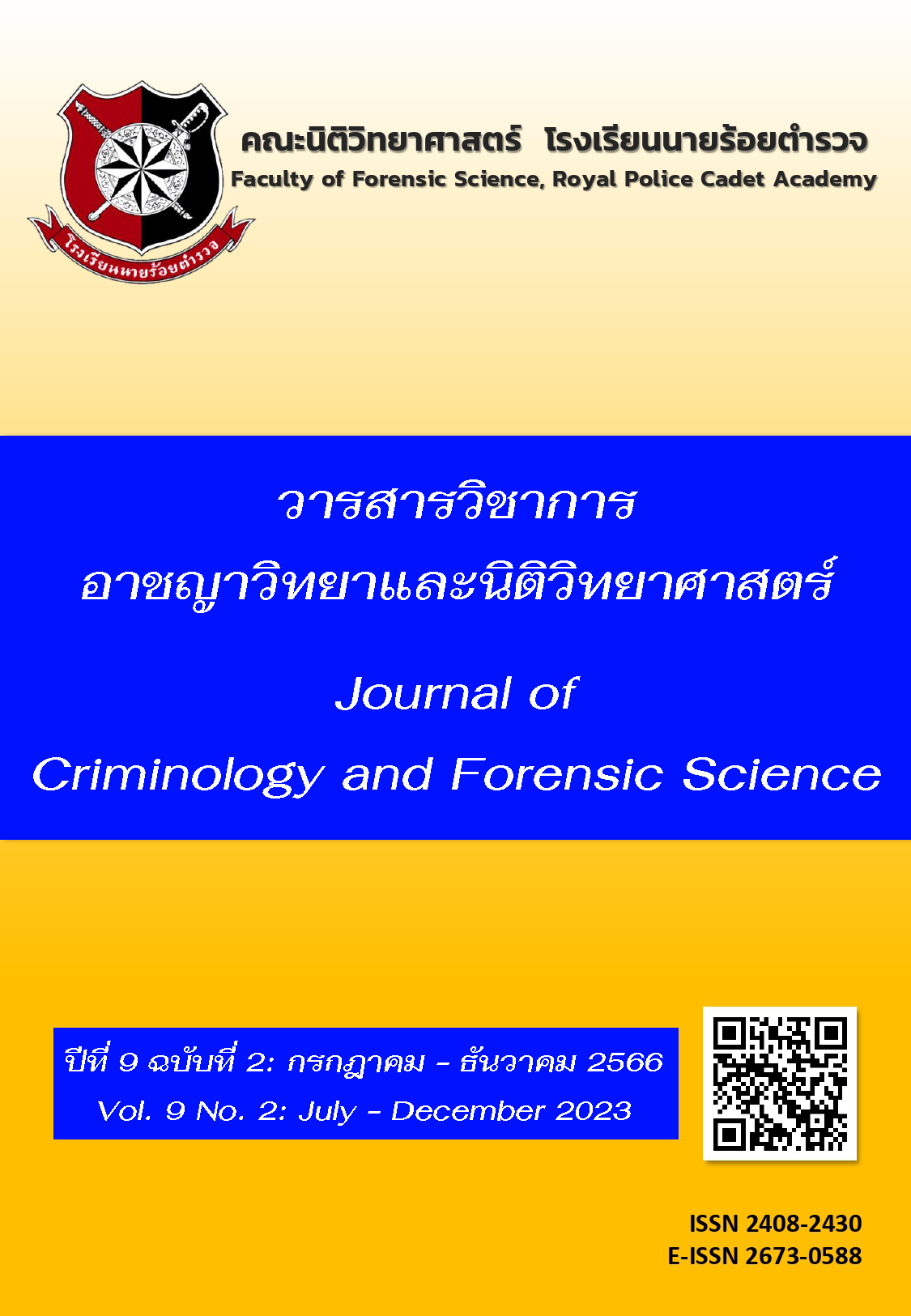การประเมินผลสัมฤทธิ์ในการนำนิติวิทยาศาสตร์ไปใช้ในการสืบสวนสอบสวนและป้องกันการกระทำความผิดซ้ำของเด็กและเยาวชน
Main Article Content
บทคัดย่อ
งานวิจัยนี้มีวัตถุประสงค์เพื่อประเมินผลสัมฤทธิ์การดำเนินงานด้านการนำนิติวิทยาศาสตร์ไปใช้ในการสืบสวนสอบสวนและป้องกันการกระทำผิดซ้ำของเด็กและเยาวชน เพื่อวิเคราะห์ปัญหาและปัจจัยแห่งความสำเร็จ และเพื่อถอดบทเรียนกรณีตัวอย่างในการดำเนินงานดังกล่าว โดยใช้วิธีการวิจัยแบบการวิจัยประเมินผลและการสัมภาษณ์เชิงลึก ผลการวิจัยพบว่า ผลสัมฤทธิ์ของการดำเนินงานดังกล่าวในภาพรวมอยู่ในระดับมาก โดยปัญหาที่ส่งผลกระทบต่อการดำเนินงาน ได้แก่ 1) ปัญหาด้านโครงสร้างและการบริหารจัดการ 2) ปัญหาด้านความเข้าใจ 3) ปัญหาด้านมุมมองหรือทัศนคติ 4) ปัญหาด้านบุคลากร 5) ปัญหาด้านขั้นตอนกระบวนการดำเนินงาน และ 6) ปัญหาด้านงบประมาณ ส่วนปัจจัยแห่งความสำเร็จ ได้แก่ 1) การจัดทำบันทึกข้อตกลง (MOU) 2) การฝึกอบรม 3) การกำหนดนโยบายของผู้บริหาร 4) ความน่าเชื่อถือและความแม่นยำของข้อมูลที่เป็นพื้นฐาน และ 5) การประชาสัมพันธ์เพื่อเผยแพร่การนำความรู้นิติวิทยาศาสตร์ไปใช้ประโยชน์ สำหรับผลการถอดบทเรียนกรณีตัวอย่างพบว่า การนำเทคนิคการตรวจสารเสพติดในเส้นผมส่งผลให้สถิติจำนวนเด็กและเยาวชนที่ถูกดำเนินคดีเกี่ยวกับยาเสพติดให้โทษลดลงอย่างต่อเนื่องในระยะ 3 ปีที่ผ่านมา ดังนั้น สำนักงานตำรวจแห่งชาติ และกระทรวงยุติธรรม จึงควรกำหนดนโยบายและแนวทางการขับเคลื่อนการนำนิติวิทยาศาสตร์ไปใช้ในการสืบสวนสอบสวนและป้องกันการกระทำผิดซ้ำของเด็กและเยาวชน พร้อมทั้งกำหนดเป็นข้อกฎหมายหรือข้อบังคับสำหรับใช้ในหน่วยงานที่เกี่ยวข้อง เพื่อให้เกิดการนำนวัตกรรมทางนิติวิทยาศาสตร์ไปใช้ประโยชน์ในกระบวนการยุติธรรมอย่างเป็นรูปธรรมต่อไป
Article Details

อนุญาตภายใต้เงื่อนไข Creative Commons Attribution-NonCommercial-NoDerivatives 4.0 International License.
เนื้อหาและข้อมูลในบทความที่ลงตีพิมพ์ใน วารสารวิชาการอาชญาวิทยาและนิติวิทยาศาสตร์ โรงเรียนนายร้อยตำรวจ ถิอว่าเป็นข้อคิดเห็นและความรั้บผิดชอบของผู้เขียนบทความโดยตรงซึ่งกองบรรณาธิการวารสาร ไม่จำเป็นต้องเห็นด้วยหรือรับผิดชอบใดๆ
บทความ ข้อมูล เนื้อหา รูปภาพ ฯลฯ ที่ได้รับการตีพิมพ์ใน วารสารวิชาการอาชญาวิทยาและนิติวิทยาศาสตร์ ถือว่าเป็นลิขสิทธิ์ของวารสาร วารสารวิชาการอาชญาวิทยาและนิติวิทยาศาสตร์ หากบุคคลหรือหน่วยงานใดต้องการนำทั้งหมดหรือส่วนหนึ่งส่วนใดไปเผยแพร่ต่อหรือเพื่อกระทำการใดๆ จะต้องได้รับอนุญาตเป็นลายลักษณ์อักษรจาก วารสารวิชาการอาชญาวิทยาและนิติวิทยาศาสตร์ ก่อนเท่านั้น
เอกสารอ้างอิง
Abma, T. A., and Stake, R. E. (2001). Stake’s responsive evaluation: Core ideas and evolution. New Directions for Evaluation, 2001(92), 7-22. https://doi.org/10.1002/ev.31
Carden, F. and Alkin, M. C. (2012). Evaluation Roots: An International Perspective. Journal of MultiDisciplinary Evaluation. 8 (17), 102–118. . Retrieved June 16, 2023. From https://journals.sfu.ca/jmde/index.php/jmde_1/article/view/348/344
Department of Juvenile Observation and Protection (2022). Case Statistics for 2022. Retrieved June 15, 2023. from https://www.djop.go.th/. (In Thai)
Leelapojanaporn, A. (2021). The Elevation of Cooperation in Utilizing Hair Drug Testing among Relevant Agencies for the Prevention of Juvenile Re-addiction. Central Institute of Forensic Science. (In Thai).
Mahacharoen, T. (2021). The Development of Capability of Officers Involved in Juvenile Cases through the Transfer of Knowledge Management Techniques regarding Forensic Science Evidence. Royal Police Cadet Academy. (In Thai).
National Research Council of Thailand. (2022). The Monitoring and Evaluation on the Utilization of Research and Innovation. Bangkok: Thanaaroonkarnpim. (In Thai).
Office of Narcotics Control Board. (2022). Notice of the Narcotics Control Board on the Criteria, Methods, and Conditions for the Inspection or Testing of Drug Substances in the Body dated 9 March 2022. (In Thai).
Organization for Economic Co-operation and Development. (2020). Evaluation Criteria. Retrieved June 15, 2023. from https://www.oecd.org/dac/evaluation/ daccriteriaforevaluatingdevelopmentassistance.htm
Pantatan, S. (2021). The Development of Techniques and the Expansion of Drug Hair Testing for the Prevention of Juvenile Drug Crime. Central Institute of Forensic Science. (In Thai).
Saruang, S. (2021). The Improvement of the Application Software to Collect Juvenile Crime Data at the Police Station Level. Royal Police Cadet Academy. (In Thai).
Scriven, M. (2011). Evaluating Evaluations: A Meta-evaluation Checklist. Retrieved June 12, 2023. from http://www.cobblestoneeval.com/wp-content/uploads/2013/05/EVALUATING_EVALUATIONS_8.16.11.pdf
Stake, R. E. and Abma, T. A. (2001). Stake’s Responsive Evaluation: Core Ideas and Evolution. New Directions for Evaluation, 92 (Winter), 7-22.


